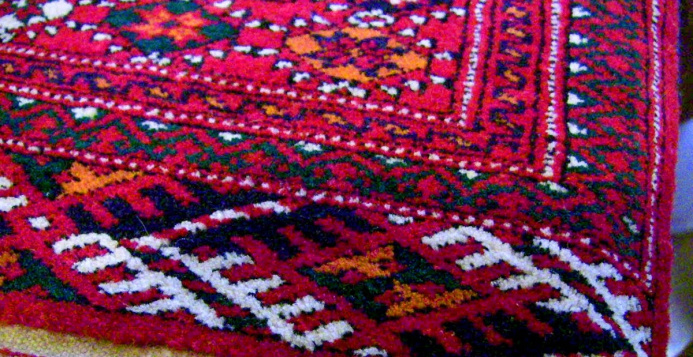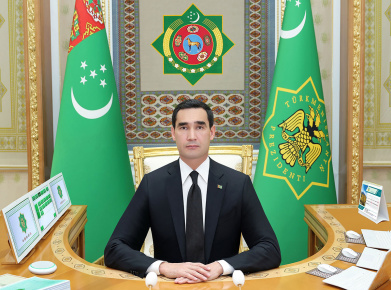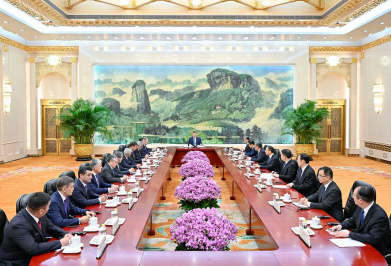Motifs woven in Turkmen carpets, or genetic memory of the people
30.05.2020 | 16:39 |The cultural heritage of Turkmenistan is famous throughout the world. One of the main components of this heritage is hand-made carpet weaving with centuries-old history and traditions.
The “golden section” rules are observed in amazing Turkmen carpets with magnificent colors, harmony expressed in a large stylish ornament.
Looking back at the past, we see that each tribe and each Turkmen oasis had their own unique pattern (gel). In these amazing ornaments, like in a polyhedron, all the wealth of spiritual and artistic culture, versatile giftedness and wisdom of the people are interwoven.
There are five main types of Turkmen carpets, like Turkmen tribal groups such as Teke (Akhalteke), Yomud, Salyr, Chovdur and Arsary.
Teke carpets and rugs are characterized by low pile, dense velvety surface and high density. The composition of the middle field pattern is formed from the two main ornamental motifs repeating in length and width.

Yomud carpets are notable for a diversity of styles and ornaments. These are created with a “dyrnak-gyol” ornament: the middle field is decorated with rhombuses framed by hooks and triangles of different sizes, or rhombuses combined with an anchor, serrate and comb motifs.
The edging framing the middle field consists of the main, widest border with an ornament on a cream-colored background. The ornament is a continuous shoot resembling a vine stem with serrated leaves extending from it.

The Salyr, the most ancient tribe in Turkmenistan, wove carpets of the same name with an octagonal, star-shaped medallion divided into 4 parts. Each part of the medallion traditionally contained animal figures.
Pendi carpets have preserved the most classical form of ancient folk ornaments created by the Turkmen Salor and Saryk tribes. These ornaments influenced the patterns of almost all kinds of Turkmen carpets. The middle field of the carpet is filled with rhythmically repeating ornamental motif “salor-gyol”. On its sides, inside and outside, are triangles.

Complex diamond-shaped Chovdur carpet motifs are usually included in a rhombic grid. The middle field is decorated with mosaic patterns, called by the local population ertman, julgur gyol, located diagonally on a dark red and brick-red background with alternating light red, dark brown, blue and cream colors.

Arsary tribes living in Turkmenistan and Uzbekistan also made carpets. The ornamental part of the Arsary carpets consists of geometric and floral patterns, derived and modified Persian and Chinese symbols.

Much has been said and written about Turkmen carpets, the “beauty woven from secrets”, and the craftswomen who wove them. After all, carefully examining the old carpet, it is possible to discover a lot, find and read in the carpet all the subtleties of craftsmanship, a heartbeat, dreams, spiritual world, sadness and joy of the carpet-makers.
Art critic A. Felkersam wrote in 1914 that anyone who has ever seen old Turkmen carpets would never confuse them with products of other tribes and peoples based on the ornament alone, not to mention the technique: “... It is impossible to give an exact description of the ornament, since the originality of its shape can be compared neither with flowers, nor with any specific geometric figures.
Art critic O. Ponomarev wrote in 1931: “In the summer days, the work of the carpet maker is so exhausting that she falls off her feet, especially when it comes to competition between women of different families... A craftswoman produces up to 3000 knots in one hour, and a huge number of blows with a comb (darak). It is easy to imagine that doing such work for 8 hours at present, and 10-12 hours in the past, every day during the long summer in Turkmenistan, the craftswoman is has overfatigue... The only need to wave tens of thousands of times a day with an iron comb weighing 1 kilogram, and not just wave, but strike it with force, all the while receiving reflected punches in the arm, can “roll off” the arms of any of our athletes... An average of 300 horsepower is applied to every carpet that we watch, admire, buy or simply walk on it, which could give light to a small city... for 8 hours”.
Carpet weaving, which has now become the job of professionals, was practiced in every Turkmen family in the past centuries. This art, embodying the genetic memory of the people, has been existing for more than 6 thousand years.











